Hubble finds new Neptune moon
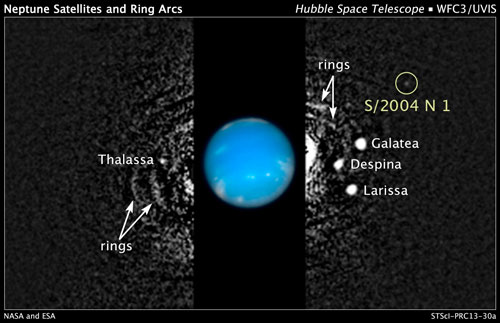 NASA's Hubble Space Telescope has discovered a new moon orbiting the distant blue-green planet Neptune. This brings the number of known satellites circling the giant planet to 14.
NASA's Hubble Space Telescope has discovered a new moon orbiting the distant blue-green planet Neptune. This brings the number of known satellites circling the giant planet to 14.
Jul 15th, 2013
Read more
 Subscribe to our Space Exploration News feed
Subscribe to our Space Exploration News feed
 NASA's Hubble Space Telescope has discovered a new moon orbiting the distant blue-green planet Neptune. This brings the number of known satellites circling the giant planet to 14.
NASA's Hubble Space Telescope has discovered a new moon orbiting the distant blue-green planet Neptune. This brings the number of known satellites circling the giant planet to 14.
Jul 15th, 2013
Read more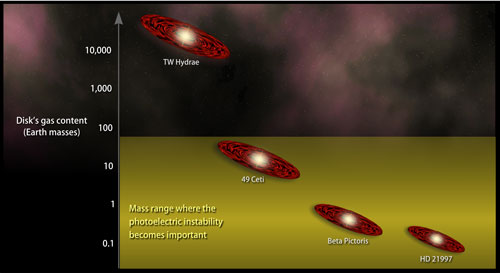 A new study by NASA scientists sounds a cautionary note in interpreting rings and spiral arms as signposts for new planets. Thanks to interactions between gas and dust, a debris disk may, under the right conditions, produce narrow rings on its own, no planets needed.
A new study by NASA scientists sounds a cautionary note in interpreting rings and spiral arms as signposts for new planets. Thanks to interactions between gas and dust, a debris disk may, under the right conditions, produce narrow rings on its own, no planets needed.
Jul 14th, 2013
Read moreA solar tsunami observed by NASA's Solar Dynamics Observatory and the Japanese Hinode spacecraft has been used to provide the first accurate estimates of the Sun's magnetic field.
Jul 11th, 2013
Read more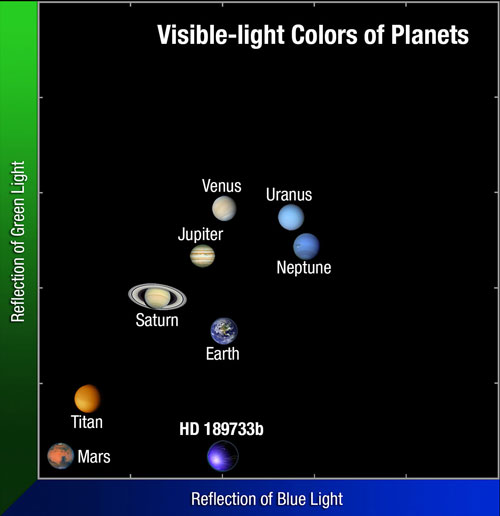 Astronomers using NASA's Hubble Space Telescope have deduced the actual visible-light color of a planet orbiting another star 63 light-years away.
Astronomers using NASA's Hubble Space Telescope have deduced the actual visible-light color of a planet orbiting another star 63 light-years away.
Jul 11th, 2013
Read more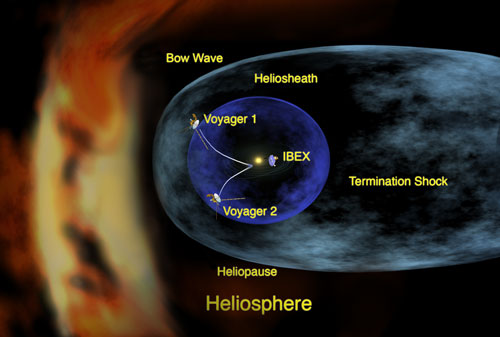 NASA's Interstellar Boundary Explorer (IBEX) spacecraft recently provided the first complete pictures of the solar system's downwind region, revealing a unique and unexpected structure.
NASA's Interstellar Boundary Explorer (IBEX) spacecraft recently provided the first complete pictures of the solar system's downwind region, revealing a unique and unexpected structure.
Jul 10th, 2013
Read more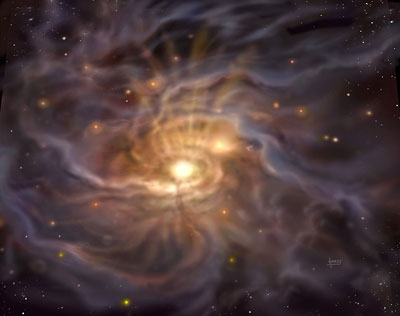 Scientists have observed in unprecedented detail the birth of a massive star within a dark cloud core about 10,000 light years from Earth.
Scientists have observed in unprecedented detail the birth of a massive star within a dark cloud core about 10,000 light years from Earth.
Jul 10th, 2013
Read more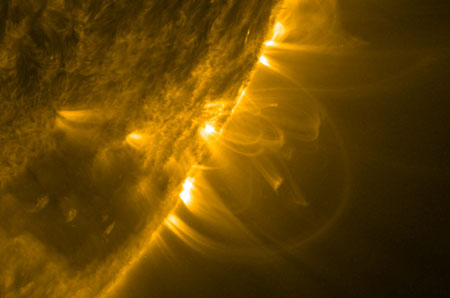 To understand how the corona is heated, some astronomers study coronal loops. These structures are shaped like an upside-down U and show where magnetic field lines are funneling solar gases or plasma. Our best photos of the sun suggest that these loops are a constant width, like strands of rope. However, new work shows that this is an optical illusion; the loops are actually tapered, wider at the top and narrower at the ends. This finding has important implications for coronal heating.
To understand how the corona is heated, some astronomers study coronal loops. These structures are shaped like an upside-down U and show where magnetic field lines are funneling solar gases or plasma. Our best photos of the sun suggest that these loops are a constant width, like strands of rope. However, new work shows that this is an optical illusion; the loops are actually tapered, wider at the top and narrower at the ends. This finding has important implications for coronal heating.
Jul 9th, 2013
Read more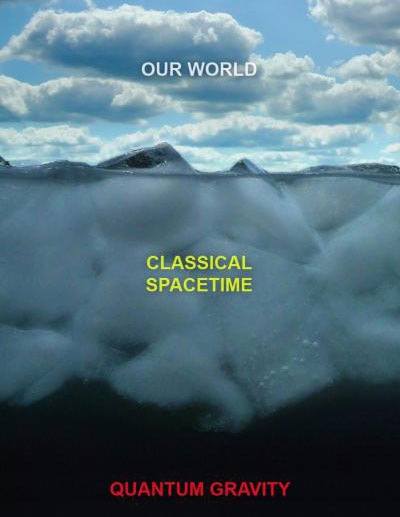 Before the Big Bang, space-time as we know it did not exist. So how was it born? The process of creating normal space-time from an earlier state dominated by quantum gravity has been studied for years by theorists at the Faculty of Physics, University of Warsaw. Recent analyses suggest a surprising conclusion: not all elementary particles are subject to the same space-time.
Before the Big Bang, space-time as we know it did not exist. So how was it born? The process of creating normal space-time from an earlier state dominated by quantum gravity has been studied for years by theorists at the Faculty of Physics, University of Warsaw. Recent analyses suggest a surprising conclusion: not all elementary particles are subject to the same space-time.
Jul 9th, 2013
Read more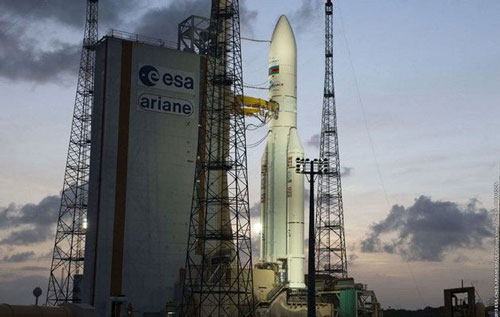 The European Space Agency has approved the final design for a next-generation rocket, Ariane 6, aimed at maintaining Europe's grip on the fast-changing market for satellite launches.
The European Space Agency has approved the final design for a next-generation rocket, Ariane 6, aimed at maintaining Europe's grip on the fast-changing market for satellite launches.
Jul 9th, 2013
Read more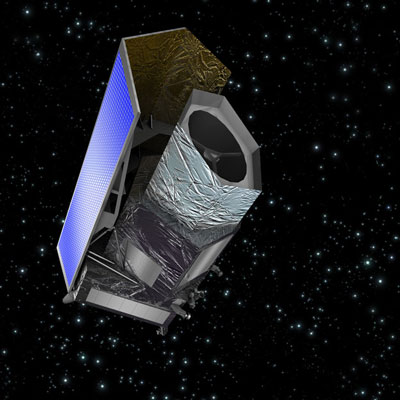 The construction of ESA's Euclid space mission to explore the 'dark Universe' will be led by Italy's Thales Alenia Space as prime contractor, beginning the full industrial phase of the project.
The construction of ESA's Euclid space mission to explore the 'dark Universe' will be led by Italy's Thales Alenia Space as prime contractor, beginning the full industrial phase of the project.
Jul 9th, 2013
Read moreResearchers, in a step toward analyzing Mars for signs of life, find that gene-sequencing chip can survive space radiation.
Jul 9th, 2013
Read more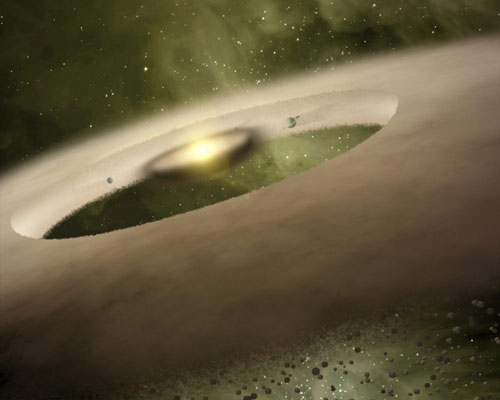 Chondrules may have formed from high-pressure collisions in early solar system.
Chondrules may have formed from high-pressure collisions in early solar system.
Jul 8th, 2013
Read more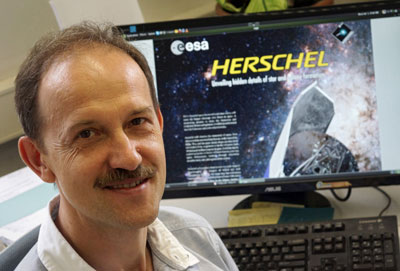 Six newly discovered debris disks not only are extremely cold, they also are lacking the characteristic dust which is always released when the rocks collide.
Six newly discovered debris disks not only are extremely cold, they also are lacking the characteristic dust which is always released when the rocks collide.
Jul 8th, 2013
Read more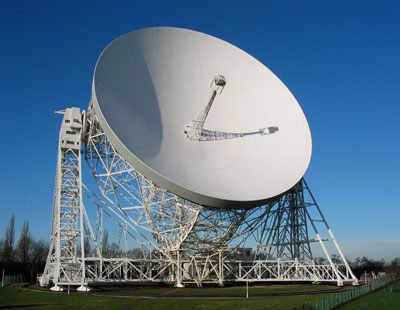 A network has been launched to promote academic research in the UK relating to the Search for ExtraTerrestrial Intelligence (SETI). The UK SETI Research Network (UKSRN) brings together academics from 11 institutions across the country.
A network has been launched to promote academic research in the UK relating to the Search for ExtraTerrestrial Intelligence (SETI). The UK SETI Research Network (UKSRN) brings together academics from 11 institutions across the country.
Jul 5th, 2013
Read more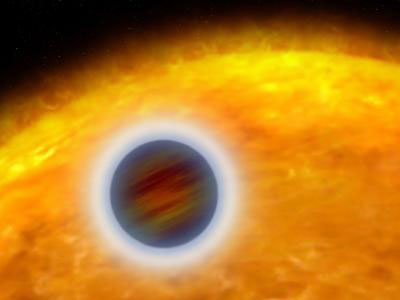 First results from the analysis of eight 'hot Jupiter' exoplanets suggest that winds and clouds play an important role in the atmospheric make up of these exotic planets.
First results from the analysis of eight 'hot Jupiter' exoplanets suggest that winds and clouds play an important role in the atmospheric make up of these exotic planets.
Jul 5th, 2013
Read more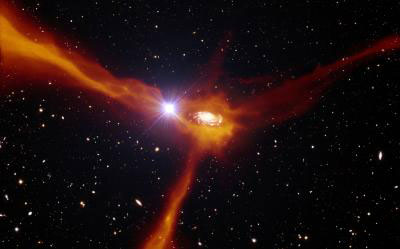 An international group of astronomers has spotted a distant galaxy hungrily snacking on nearby gas. The gas is seen to fall inward toward the galaxy, creating a flow that both fuels star formation and drives the galaxy's rotation. This is the best direct observational evidence so far supporting the theory that galaxies pull in and devour nearby material in order to grow and form stars.
An international group of astronomers has spotted a distant galaxy hungrily snacking on nearby gas. The gas is seen to fall inward toward the galaxy, creating a flow that both fuels star formation and drives the galaxy's rotation. This is the best direct observational evidence so far supporting the theory that galaxies pull in and devour nearby material in order to grow and form stars.
Jul 5th, 2013
Read more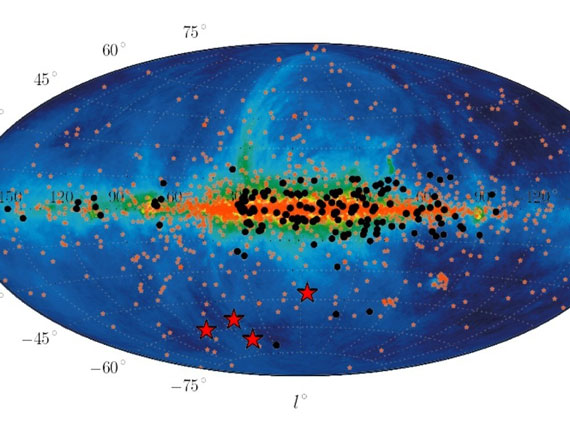 Cosmic radio bursts point to cataclysmic origins in the distant universe.
Cosmic radio bursts point to cataclysmic origins in the distant universe.
Jul 4th, 2013
Read more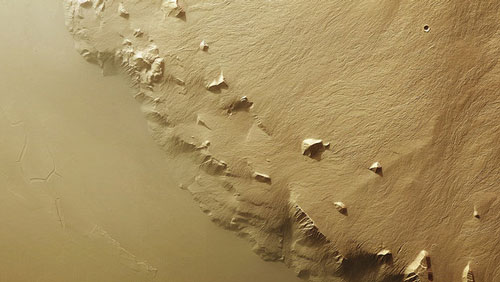 Hundreds of individual lava flows are seen frozen in time on the flanks of Olympus Mons, the largest volcano in the Solar System. Images taken by ESA's Mars Express focus on the southeast segment of the giant volcano, which towers some 22 km above the surrounding plains.
Hundreds of individual lava flows are seen frozen in time on the flanks of Olympus Mons, the largest volcano in the Solar System. Images taken by ESA's Mars Express focus on the southeast segment of the giant volcano, which towers some 22 km above the surrounding plains.
Jul 4th, 2013
Read more